Note. catalog number of the radiator and its mounts see here.
see also Replacing the radiator of the air conditioner.
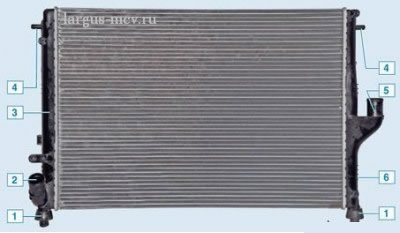
Radiator: 1 - rubber cushion of the lower mount; 2 - outlet pipe; 3 - left tank; 4 – top fastening pin; 5 - inlet pipe; 6 - right tank
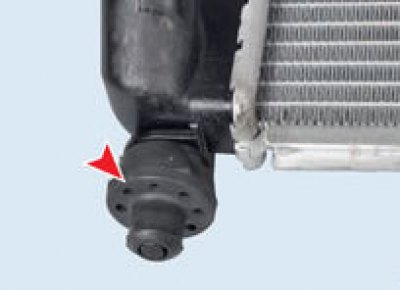
Radiator rubber pad
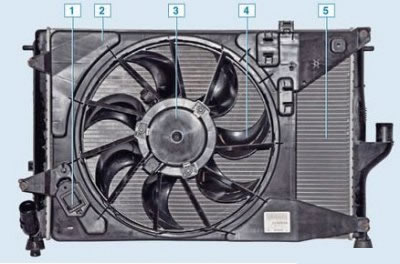
Radiator assembly with fan: 1 - additional resistor; 2 - casing; 3 - electric motor; 4 - impeller; 5 - radiator
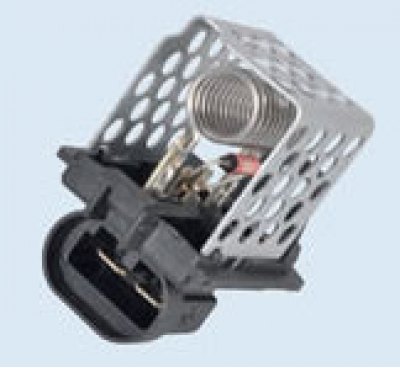
Additional fan resistor
Radiator Care
The windward surfaces of the radiator can become contaminated with insect debris, leaves and other particles after a certain period of vehicle operation. In this case, the blockage will affect the operation of the air conditioner and cooling system, and may cause the air conditioner to malfunction, as well as the cooling system to overheat, etc. Therefore, it is recommended to clean the radiator and condenser.
The front side of the radiator surface should be cleaned once a year. Pressurized water or air can be used to clean the radiator fins and blow out leaf and insect debris. The condenser is flushed by direct blowing through the radiator.
Water and air pressure should not exceed 150 kPa. Pressure above 150 kPa can damage the condenser and radiator fins.
The heatsink fins must be maintained in a condition that ensures good heat transfer. they cannot be brushed. Otherwise, damage to the plates may result in reduced heat transfer.
Under no circumstances should water be sprayed on a hot radiator, as the release of hot steam can be harmful. The use of cleaning water can only be used when the engine is idle or cool.
Removing
Put the car on a two-post lift, apply the parking brake, turn off the ignition and disconnect the wire terminal "masses" from the battery.
Remove engine crankcase protection (see here).
Remove front bumper (see here).
Drain the liquid from the engine cooling system (see here).
Flush the engine cooling system (see ibid).
For vehicles with power steering
Remove the tank 1, Figure 13-4, of the power steering pump from the mounting bracket without disconnecting the pipelines, and tie it to the engine.
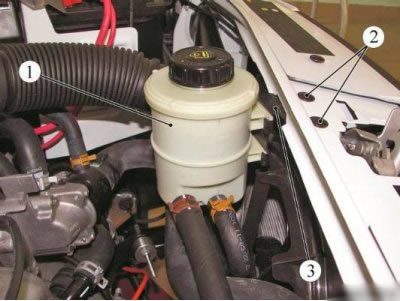
Figure 13-4 - Disconnecting the power steering pump reservoir: 1 - reservoir of the power steering pump; 2 - fastening screw; 3 - an arm of fastening of a reservoir of the pump of the hydraulic booster of a steering
Unscrew two screws 2 and remove the bracket 3 for fastening the reservoir of the power steering pump (T30 Torx screwdriver).
Operations for all vehicle configurations
Remove the clamps of the inlet and outlet hoses of the radiator of the engine cooling system (clamp remover Mot. 1448).

Disconnect the inlet and outlet hoses of the radiator of the cooling system.
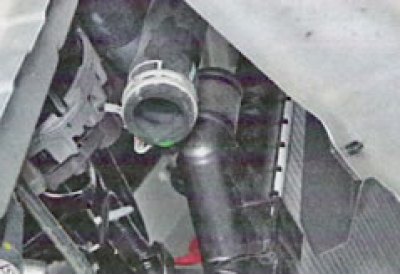
For vehicles with air conditioning
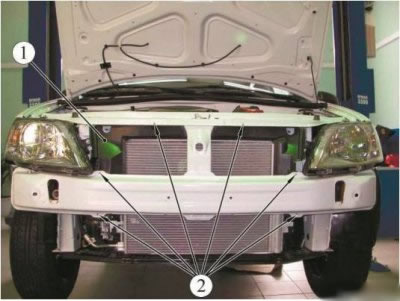
Figure 13-5 - Removing the air baffle: 1 - air deflector; 2 - air deflector mounting screw
Disconnect the wiring harness from the holder on the electric fan.
Disconnect the A/C piping from the holder on the electric fan.
Remove the two screws securing the condenser (air conditioner radiator) to the radiator of the engine cooling system...
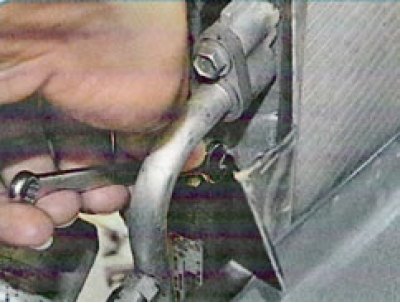
Disconnect the condenser 2, Figure 13-6, of the air conditioner from the radiator of the engine cooling system (flat screwdriver).
Remove air baffle 1, Figure 13-5.
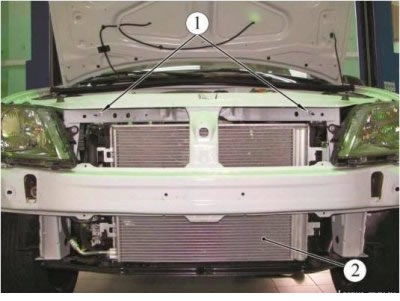
Figure 13-6 - Disconnecting the air conditioning condenser from the radiator of the engine cooling system: 1 - a bolt of fastening of an arm of a radiator; 2 - air conditioner condenser
Attach the air conditioner condenser to the upper cross member.
Operations for all vehicle configurations
Remove the engine cooling fan (see here).
Unscrew bolts 1, Figure 13-7, fastening the radiator bracket to the car body (interchangeable head 10, extension, ratchet knob).
Remove radiator mounting brackets 2 from engine cooling radiator.
Remove the radiator 1, Figure 13-8, of the engine cooling system from the mounting on the front suspension subframe and remove the radiator.
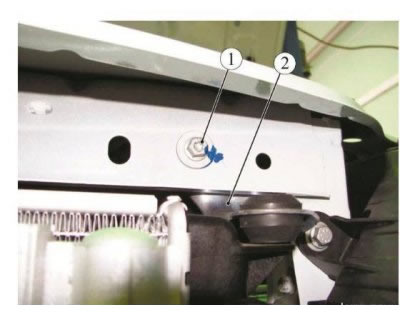
Figure 13-7 - Upper mounting of the radiator of the engine cooling system: 1 - a bolt of fastening of an arm of a radiator; 2 - radiator mounting bracket
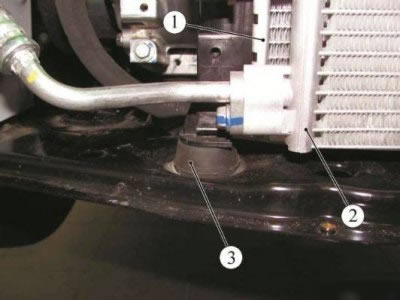
Figure 13-8 - Lower mounting of the radiator of the engine cooling system: 1 - radiator of the engine cooling system; 2 - air conditioner condenser; 3 - lower radiator mount
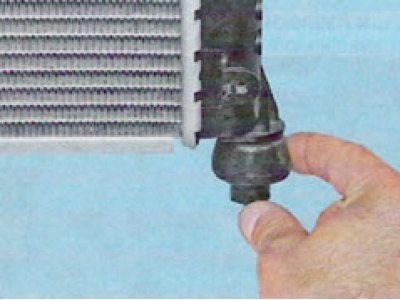
The pins at the bottom of each radiator tank are rubber padded (supports) radiator. Take them off. Replace heavily compressed or hardened pads.
Installation
Install the engine cooling radiator to the lower mountings on the front suspension subframe.
Install brackets 2, Figure 13-7, fixing the radiator to the radiator of the cooling system.
Install and tighten bolts 1 securing the radiator bracket to the body. Tightening torque for radiator bracket bolts 8 Nm (0.8 kgf·m) (interchangeable head 10, extension, ratchet knob, torque wrench).
Install the engine cooling fan (see below).
Connect the inlet and outlet hoses to the cooling system radiator.
Install new radiator inlet and outlet hose clamps (clamp remover Mot. 1448).
For vehicles with air conditioning
Install and fix the air conditioner condenser on the radiator of the engine cooling system.
Install the air baffle 1, Figure 13-5, and fix it with clamps to the car body (T30 Torx screwdriver).
Attach the power steering pipe to the holder on the steering fan.
Connect the wiring harness to the holder on the electric fan.
Connect the air conditioning piping to the holder on the electric fan.
For vehicles with power steering
Install bracket 3, Figure 13-4, fastening the power steering pump reservoir and fix with two screws 2 (Torx screwdriver TK0).
Install the reservoir 1 of the power steering pump on the mounting bracket.
Operations for all vehicle configurations
Fill the engine cooling system (see above).
Install the engine crankcase protection.
Install the front bumper.
Attach wire terminal "masses" to the battery.
Remove air from the engine cooling system (see above).
